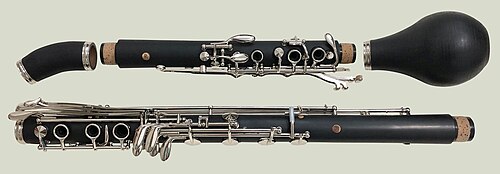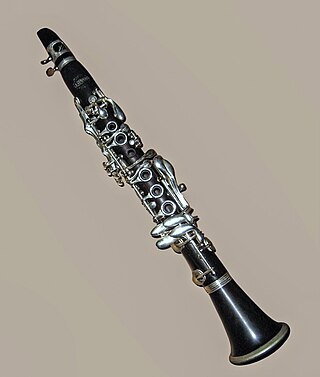 Two historical clarinets d'amore | |
| Woodwind instrument | |
|---|---|
| Classification | |
| Developed |
|
| Playing range | |
1. Contents
| |
| Related instruments | |
The clarinet d'amore or clarinet d'amour is a musical instrument, a member of the clarinet family.
 Two historical clarinets d'amore | |
| Woodwind instrument | |
|---|---|
| Classification | |
| Developed |
|
| Playing range | |
1. Contents
| |
| Related instruments | |
The clarinet d'amore or clarinet d'amour is a musical instrument, a member of the clarinet family.

In comparison with the B♭ and A soprano clarinets, the clarinet d'amore has a similar shape and construction, but is generally larger, usually pitched in G. [a] The clarinet d'amore has proportionally smaller tone holes and a proportionally smaller bore compared to the soprano clarinet, generally around the same size as the bore and tone holes found on the soprano clarinet itself. The instrument also has a pear-shaped or globular bell (called Liebesfuss) similar to that of the cor anglais; these features give the instrument its distinctive timbre. Due to their large size, they also feature a curved metal neck to bring the instrument to a more comfortable playing position, though instruments with curved wooden necks exist. Fingerings are generally the same as other members of the clarinet family, however modern examples often have an extension, like the basset horn, allowing them to play an additional 4 semitones.
In addition to the larger sizes, clarinet d'amore have also been constructed in C, B♭ and A, however these do not appear to fill the same musical role as the larger instruments. It has been suggested that these smaller instruments may have been made for aesthetic reasons rather than to serve a musical role.
The clarinet d'amore first appeared in southern Germany around 1740, predating the more widely known basset horn by several decades. It has been conjectured that the basset horn, which at the time shared the features of low pitch and a small bore, was developed from the clarinet d'amore. Early instruments featured only 3 or 4 keys, though later instruments from the 19th century, such as an example by Wilhelm Heckel GmbH, have as many as 14 keys. At least 69 extant clarinet d'amour from the 18th and 19th century have survived to the modern era, suggesting the instrument did experience some popularity. By the mid 19th century the instrument was considered obsolete, however Heckel would continue to offer them until the early 20th century. [1]

Recently efforts have been made to resurrect the clarinet d'amore in both period correct and modern forms. Modern developments include a recording project led by Vlad Weverbergh of music by Henri-Joseph de Croes for historical clarinets d'amore (available from Etcetera Records) [2] and the development of an extended modern clarinet d'amore in G (with a written range to low C3, sounding G2) by Richard Haynes, [3] and Schwenk & Seggelke. [4]

Works for or including clarinet/clarinette/clarinetto d'amore/d'amour/dolce or "in G" include:
The clarinet is a single-reed musical instrument in the woodwind family, with a nearly cylindrical bore and a flared bell.

The oboe is a type of double-reed woodwind instrument. Oboes are usually made of wood, but may also be made of synthetic materials, such as plastic, resin, or hybrid composites.

The bass clarinet is a musical instrument of the clarinet family. Like the more common soprano B♭ clarinet, it is usually pitched in B♭, but it plays notes an octave below the soprano B♭ clarinet. Bass clarinets in other keys, notably C and A, also exist, but are very rare. Bass clarinets regularly perform in orchestras, wind ensembles and concert bands, and occasionally in marching bands, and play an occasional solo role in contemporary music and jazz in particular.

The basset horn is a member of the clarinet family of musical instruments.

The basset clarinet is member of the clarinet family similar to the usual soprano clarinet but longer and with additional keys to enable playing several additional lower notes. Typically a basset clarinet has keywork going to a low (written) C or B, as opposed to the standard clarinet's E or E♭. The basset clarinet is most commonly a transposing instrument in A, although basset clarinets in C and B♭ and very seldom in G also exist. The similarly named basset horn is also a clarinet with extended lower range, but is in a lower pitch ; the basset horn predates, and undoubtedly inspired, the basset clarinet.

A clarinet concerto is a concerto for clarinet; that is, a musical composition for solo clarinet together with a large ensemble. Albert Rice has identified a work by Giuseppe Antonio Paganelli as possibly the earliest known concerto for solo clarinet; its score appears to be titled "Concerto per il Clareto" and may date from 1733. It may, however, be intended for soprano chalumeau. There are earlier concerti grossi with concertino clarinet parts including two by Johann Valentin Rathgeber, published in 1728.

The contra-alto clarinet, E♭ contrabass clarinet, is a large clarinet pitched a perfect fifth below the B♭ bass clarinet. It is a transposing instrument in E♭ sounding an octave and a major sixth below its written pitch, between the bass clarinet and the B♭ contrabass clarinet.

A soprano clarinet is a clarinet that is higher in register than the basset horn or alto clarinet. The unmodified word clarinet usually refers to the B♭ clarinet, which is by far the most common type. The term soprano also applies to the clarinets in A and C, and even the low G clarinet—rare in Western music but popular in the folk music of Turkey—which sounds a whole tone lower than the A. While some writers reserve a separate category of sopranino clarinets for the E♭ and D clarinets, those are generally regarded as soprano clarinets as well. All have a written range from the E below middle C to about the C three octaves above middle C, with the sounding pitches determined by the particular instrument's transposition.
The alto clarinet is a woodwind instrument of the clarinet family. It is a transposing instrument pitched in the key of E♭, though instruments in F have been made. In size it lies between the soprano clarinet and the bass clarinet. It bears a greater resemblance to the bass clarinet in that it typically has a straight body, but a curved neck and bell made of metal. All-metal alto clarinets also exist. In appearance it strongly resembles the basset horn, but usually differs in three respects: it is pitched a whole step lower, it lacks an extended lower range, and it has a wider bore than many basset horns.

The A-flat (A♭) clarinet is the highest-pitched instrument of the clarinet family still manufactured. It is just over half the length of the common B♭ clarinet and pitched a minor seventh higher, a perfect fourth higher than the E♭ clarinet. As a transposing instrument it sounds a minor sixth higher than written, thus the lowest written note E3 sounds as concert C4 (middle C). Around the beginning of the 19th century, several small clarinets in different pitches appeared. The A♭ clarinet was adopted in European wind bands, particularly in Italy where it has appeared in Verdi's opera banda parts and survived to the present day in military bands. It is sometimes called for in contemporary classical music, in works by composers Béla Bartók and John Tavener, and in large clarinet choir works. It is manufactured by Italian makers Ripamonti and Orsi, and in Germany by Foag Klarinetten, Herbert Wurlitzer, and Schwenk & Seggelke.
The flûte d'amour, sometimes called a Mezzo-Soprano flute, is an uncommon member of the Western concert flute family, pitched in A♭, A, or B♭ and is intermediate in size between the modern C concert flute and the alto flute in G. It is sometimes thought of as the mezzo-soprano member of the flute family.

The clarinet family is a woodwind instrument family of various sizes and types of clarinets, including the common soprano clarinet in B♭ and A, bass clarinet, and sopranino E♭ clarinet.
The Western concert flute family has a wide range of instruments.
Reed aerophones is one of the categories of musical instruments found in the Hornbostel-Sachs system of musical instrument classification. In order to produce sound with these Aerophones the player's breath is directed against a lamella or pair of lamellae which periodically interrupt the airflow and cause the air to be set in motion.

Richard Elliot Haynes is an Australian clarinettist residing in Switzerland. He performs music spanning the 16th to 21st centuries worldwide, but predominantly music by living composers, in a multitude of contexts.

Seggelke Klarinetten, is a German clarinet manufacturer based in Bamberg in the Bavarian Upper Franconia. The company manufactures clarinets of a variety of fingering systems. A specialty of the company is the reproduction of historical clarinets.

A Liebesfuss or Liebesfuß is a pear- or bulb-shaped element that narrows to a small opening in double reed instruments such as the oboe d'amore, cor anglais and heckelphone, as well as on some single reed instruments. It serves as a damper that gives these musical instruments a characteristically soft timbre. It is the eponymous characteristic of the oboe d'amore, which was developed in the baroque alongside other particularly sweet-sounding instruments such as the viola d'amore and the clarinet d'amore, which originated around 1740, died out in the mid-19th century, and was redeveloped from 2017 to 2020 on the basis of a basset clarinet in G.